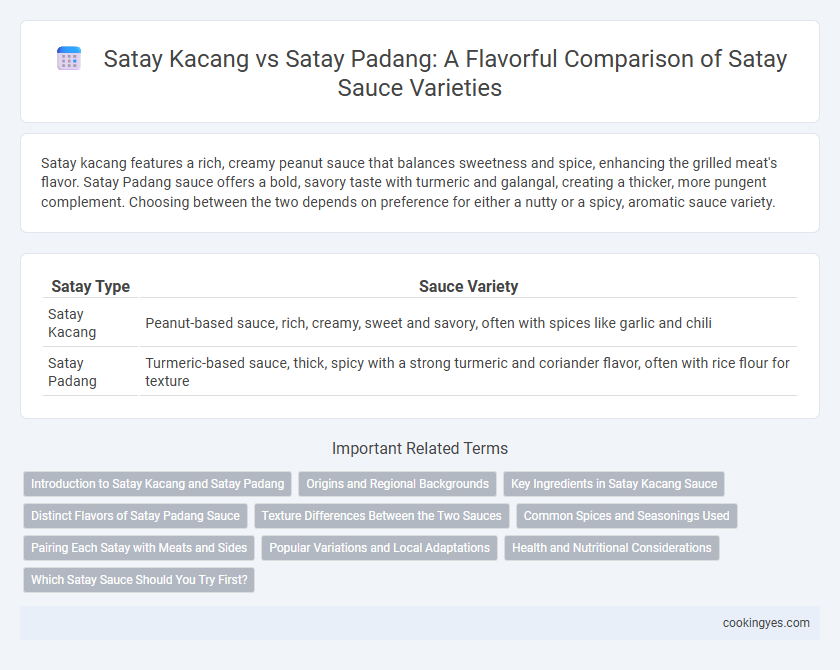Satay kacang features a rich, creamy peanut sauce that balances sweetness and spice, enhancing the grilled meat's flavor. Satay Padang sauce offers a bold, savory taste with turmeric and galangal, creating a thicker, more pungent complement. Choosing between the two depends on preference for either a nutty or a spicy, aromatic sauce variety.
Table of Comparison
| Satay Type | Sauce Variety |
|---|---|
| Satay Kacang | Peanut-based sauce, rich, creamy, sweet and savory, often with spices like garlic and chili |
| Satay Padang | Turmeric-based sauce, thick, spicy with a strong turmeric and coriander flavor, often with rice flour for texture |
Introduction to Satay Kacang and Satay Padang
Satay Kacang features a rich peanut sauce made from roasted peanuts, coconut milk, and a blend of spices, offering a creamy and mildly sweet flavor profile. Satay Padang stands out with its thick, savory sauce made from beef broth, turmeric, lemongrass, and chili, delivering a bold and spicy taste that complements grilled meat skewers. These distinct sauce varieties highlight regional Indonesian flavors and enhance the satay experience through their unique ingredient combinations.
Origins and Regional Backgrounds
Satay kacang, originating from Java, features a rich, creamy peanut sauce that reflects the island's abundant peanut cultivation and culinary tradition. Satay Padang hails from West Sumatra and is distinguished by its thick, spicy, turmeric-based sauce made from yellow beans and various local spices, showcasing the region's Minangkabau influence. Both sauces embody their respective regional flavors, with Satay kacang highlighting Javanese sweetness and Satay Padang emphasizing Sumatran boldness.
Key Ingredients in Satay Kacang Sauce
Satay kacang sauce features a rich blend of roasted peanuts, tamarind, garlic, palm sugar, and a touch of chili for balanced sweetness and heat. This peanut-based sauce contrasts with Satay Padang's thicker, spicy, turmeric-infused sauce made from rice flour and beef broth. The key ingredient in Satay kacang sauce is the ground roasted peanut, providing creamy texture and nutty flavor essential to Indonesian satay dishes.
Distinct Flavors of Satay Padang Sauce
Satay Padang sauce is distinguished by its thick, spicy, and turmeric-infused yellow gravy, blending rich spices, peanuts, and a touch of coconut milk for a savory depth that contrasts the simpler peanut sauce of Satay Kacang. This sauce features a bold combination of herbs and spices such as galangal, lemongrass, and chili, offering a complex and aromatic flavor profile unique to West Sumatra. The intense, slightly tangy, and peppery taste of Satay Padang sauce elevates the grilled meat experience beyond the milder, sweeter peanut-based Satay Kacang sauce.
Texture Differences Between the Two Sauces
Satay kacang sauce features a creamy, smooth texture derived from ground roasted peanuts blended with coconut milk, giving it a rich and slightly thick consistency. In contrast, Satay Padang sauce is characterized by a thicker, more gelatinous texture due to the use of rice flour and a spicy, savory broth base that creates a sticky, robust coating. These textural differences make Satay kacang ideal for a velvety dip experience, while Satay Padang provides a hearty, clingy sauce that intensifies flavor adherence to the satay skewers.
Common Spices and Seasonings Used
Satay kacang sauce typically features a rich blend of ground peanuts, garlic, shallots, coriander, turmeric, and chili, creating a creamy and mildly spicy flavor profile. Satay Padang sauce is characterized by its thicker, spicy gravy made from rice flour, turmeric, ginger, garlic, lemongrass, and chili, offering a distinct, earthy heat. Both sauces incorporate Indonesian spices, but Satay kacang leans towards nutty sweetness while Satay Padang emphasizes bold, savory heat.
Pairing Each Satay with Meats and Sides
Satay kacang features a rich peanut sauce that pairs exceptionally well with chicken or beef satay, complemented by steamed rice cakes, known as lontong, and fresh cucumber slices to balance the nutty flavors. Satay Padang, with its spicy, turmeric-infused yellow sauce, is traditionally served with beef or offal satay and accompanied by ketupat (compressed rice cakes) and slices of shallots for added texture and aroma. Each sauce brings a distinct regional flavor profile, enhancing the meats and sides specific to their cultural origins.
Popular Variations and Local Adaptations
Satay kacang features a rich, creamy peanut sauce that is a staple across Indonesia and Malaysia, highlighting the versatility of ground roasted peanuts blended with spices. Satay Padang, originating from West Sumatra, is distinct with its savory, thick yellow sauce made from rice flour and turmeric, offering a bold, spicy alternative favored in local street food scenes. Both variations showcase regional preferences and adaptations, reflecting diverse ingredient availability and cultural taste profiles in traditional satay cuisine.
Health and Nutritional Considerations
Satay kacang sauce, made primarily from crushed peanuts, offers a rich source of healthy fats, protein, and essential nutrients such as magnesium and vitamin E, supporting heart health and muscle function. Satay Padang sauce, typically featuring a thicker, spicier, and turmeric-infused gravy, provides anti-inflammatory benefits and antioxidants from turmeric and chili peppers but may contain higher sodium levels due to added seasonings. Choosing between these sauces depends on dietary goals, with satay kacang favoring nutrient density and satay Padang offering metabolic and digestive health benefits through its spice profile.
Which Satay Sauce Should You Try First?
Satay kacang features a rich, creamy peanut sauce with a slightly sweet and savory flavor, making it a popular choice for first-timers seeking a familiar taste. Satay padang offers a bold, spicy, and turmeric-infused sauce that delivers a unique, aromatic experience ideal for those craving a more intense flavor profile. Choosing between the two depends on your preference for either the smooth, nutty notes of Satay kacang or the vibrant, complex spices of Satay padang sauce.
Satay kacang vs Satay padang for sauce variety Infographic

 cookingyes.com
cookingyes.com